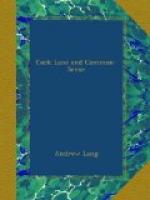ANCIENT SPIRITUALISM.
M. Littre on ‘demoniac affections,’ a subject, in his opinion, worthy of closer study. Outbreak of Modern Spiritualism. Its relations to Greek and Egyptian Spiritualism recognised. Popular and literary sources of Modern Spiritualism. Neoplatonic thaumaturgy not among these. Porphyry and Iamblichus. The discerning of Spirits. The ancient attempts to prove ’spirit identity’. The test of ‘spirit lights’ in the ancient world. Perplexities of Porphyry. Dreams. The Assynt Murder. Eusebius on Ancient Spiritualism. The evidence of Texts from the Papyri. Evocations. Lights, levitation, airy music, anaesthesia of Mediums, ancient and modern. Alternative hypotheses: conjuring, ‘suggestion’ and collective hallucination, actual fact. Strange case of the Rev. Stainton Moses. Tabular statement showing historical continuity of alleged phenomena.
In the Revue des Deux Mondes, for 1856, tome i., M. Littre published an article on table-turning and ‘rapping spirits’. M. Littre was a savant whom nobody accused of superstition, and France possessed no clearer intellect. Yet his attitude towards the popular marvels of the day, an attitude at once singular and natural, shows how easily the greatest minds can pay themselves with words. A curious reader, in that period of excitement about ‘spiritualism,’ would turn to the Revue, attracted by M. Littre’s name. He would ask: ’Does M. Littre accept the alleged facts; if so, how does he explain them?’ And he would find that this guide of human thought did not, at least, reject the facts; that he did not (as he well might have done) offer imposture as the general explanation; that he regarded the topic as very obscure, and eminently worthy of study,—and that he pooh-poohed the whole affair!
This is not very consistent or helpful counsel. Like the rest of us, who are so far beneath M. Littre in grasp and in weight of authority, he was subject to the idola fori, the illusions of the market-place. It would never do for a great scientific sceptic to say, ’Here are strange and important facts of human nature, let us examine them as we do all other natural phenomena,’ it would never do for such a man to say that without qualification. So he concluded his essay in the pooh-pooh tone of voice. He first gives a sketch of abnormalities in mortal experience, as in the case of mental epidemics, of witchcraft, of the so-called prophets in the Cevennes, of the Jansenist marvels. He mentions a nunnery where, ‘in the sixteenth century,’ there occurred, among other phenomena, movements of inanimate objects, pottery specially distinguishing itself, as in the famous ‘Stockwell mystery’. Unluckily he supplies no references for these adventures.’ {57} The Revue, being written for men and women of the world, may discuss such topics, but need not offer exact citations. M. Littre, on the strength of his historical sketch, decides, most correctly, that there is rien de nouveau, nothing new, in the spirit-rapping epidemic. ’These maladies never desert our race.’ But this fact hardly explains why ‘vessels were dragged from the hands’ of his nuns in the sixteenth century.




